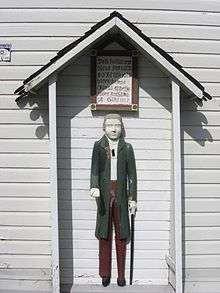Poor man statue
Poor man statues (Finnish: Vaivaisukko, Swedish: Fattiggubbe) are carved wooden statues placed outside Lutheran churches in Finland and in Sweden. Statues represent a poor and often disabled man begging for an alm. The figures have usually a small money box inside and a slot in the chest for inserting a coin. They were used from 17th to 19th century for collecting money to the poor.[1][2]
History
The origin of poor man statues dates back to 1649 as the Queen Christina gave an order to place so called "poor logs" or "offertory logs" to churches and other public places. Soon the local carpenters started to modify these hollow wooden logs as beggar look-a-likes. Tallest of these sculptures are near man-sized.[1] A Biblical sentence is often written above the statue.
Today there are 144 poor man statues and one poor woman statue in Finland, while Sweden has only nine known ones left. Most of the Finnish statues are found in the rural areas of Western Finland, especially in the Ostrobothnia region. A large number of sculptures have been destroyed by fire, they have been robbed or vandalized otherwise. The oldest known statues in Finland are the ones outside churches of Hauho and Raahe. They date from the late 17th century. Most of the poor man statues are from the early 19th century and many of them represent a retired soldier who's been disabled in the Finnish War.[3]
See also
References
- 1 2 Sartenada's photo blog Retrieved 22 June 2013.
- ↑ Redtree Times, Poor Man Statues Retrieved 22 June 2013.
- ↑ Vaivaisukot Kerimäellä (in Finnish). Retrieved 22 June 2013.
External links
-
 Media related to Poor man statues at Wikimedia Commons
Media related to Poor man statues at Wikimedia Commons
